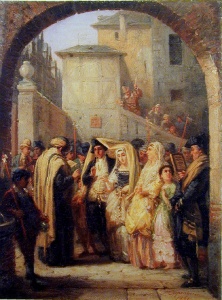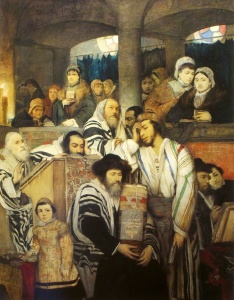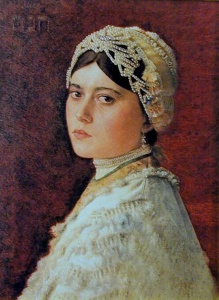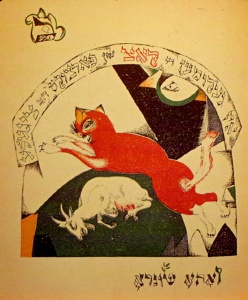The Past and Future Collide
As the Enlightenment marched across Europe in the form of the Napoleonic conquests the effects on Jewish Art were unmistakable. Ghetto walls were breached and torn down exposing the Jewish population and its artists to a myriad of Christian and secular influences. While traditional Judaica continued to be fashioned by artisans, synagogues ornamented and books and Haggadahs illustrated, many Jewish artists now became aware of another kind of artistic expression; the art object itself. Painting became a legitimate mode of Jewish cultural expression. In this outburst of artistic freedom Moritz Oppenheim (1800-1882) is the undisputed father of Jewish painting in the nineteenth century.

Oppenheim was born in the ghetto in Hanau, Germany in 1800. Educated in heder and Talmud Torah he nonetheless made a quick transition to secular studies and art school upon the emancipation of the Jews in 1806. After studying in Frankfurt, Munich, Paris and Rome he returned to Frankfort to pursue a successful career painting society portraits (especially the Rothschilds) and academic visions of biblical scenes. In 1865 he launched upon a series depicting scenes of eighteenth century Jewish life much like the world of his childhood. This series, Pictures of Traditional Jewish Family Life, would become his most lasting contribution to Jewish Art. These images of Shabbos, Yom Tov, weddings and many other Jewish communal and family scenes were quickly reproduced in bound albums and were soon found in almost every German Jewish home. They were the encapsulation of the world that once was and was now slowly disappearing.
Oppenheim’s work represents the seminal encounter between Jewish tradition and the challenges of the modern world. The Pictures of Traditional Jewish Family Life became a visual anchor for many Jews caught in the sweep of emancipation, nationalism and modernity. Providing a sense of identity, even with a sentimental vision of a vanishing Jewish world, would help keep Jews in the fold for at least another generation.

That next generation could be characterized by Maurycy Gottlieb (1856-1879), a singular artist from eastern Galicia (Drohobycz) who painted the masterpiece Jews Praying on the Day of Atonement in 1878 one year before he died at the age of twenty-three. He was the child of progressive parents, studied at the art schools in Lemberg and Vienna and quickly began painting subjects of Polish history, Shakespeare and the Bible, including some Christian scenes. In his brief career he saw both his Jewish heritage and all of European civilization as his cultural birthright. While stillborn, his work seeks to thrust Jewish subjects and sensibilities into the heart of modern thought. Oppenheim looked to the past while Gottlieb yearned for the future.

Isidor Kaufmann (1853-1921) continues the movement of Jewish Art into the Modern through a wonderfully subversive methodology. Born in Arad, Hungary, Kaufmann took up painting in Vienna and was soon drawn to the mysterious world of the shtetl and Hasidic life in Galicia, Poland and Ukraine. In annual field trips he would collect images; portraits, costumes, interiors and genre scenes that would be transformed into glistening narrative gems of Jewish life for his eager customers; assimilated, rich Viennese Jews. His best works, mainly portraits of young Hasidic men and women impeccably dressed for Yom Tov, are beautifully and simply composed paintings that reveal subtle psychological insights. A masterful sensitivity opens up the vibrant inner life of his subjects and transforms clichés into a powerful combination of psychology and flat modern image making. Kaufmann, always the realist bound to nineteenth century aesthetics, nonetheless brings Freud’s revelations to bear on a shallow modern pictorial space.

For Jews the leap into Modern Art was made in the cauldrons of revolution; Bolshevik Russia, Zionist Palestine and Paris, France. In the work of El Lissitzky (1890-1941), modernity subsumes tradition. Had Gadya is his Jewish Art masterpiece. He grew up in Vitebsk, Russia and after the 1917 revolution joined Chagall teaching in the Vitebsk art school. Deeply involved in the movement to recreate Jewish culture in Russia especially in the publication and illustration of Yiddish books his Had Gadya of color lithographs were published in Kiev in 1919. Soon after El Lissitzky turned his attention to the most radical modern art movement of the time, Constructivism. Along with fellow Russian, Casimir Malevich, he created a totally abstract visual language, merging aspects of painting and architecture. The seeds of this new vision are clearly visible in Had Gadya. Combining vivid imagery (such as the savage fury of the red cat leaping over the slain goat), a text border and bold abstract shapes the artist breaks out of nineteenth century naturalism into the drama and uncertainty of a new age.
That new age is in many ways the world we still live in. Subsequent Jewish Art would continue to struggle between textual traditions and visual innovations we associate with Modern Art. We shall see, however, that this matrix, which seems superficially to create tension and conflict, actually is the source of much of the Twentieth Century’s visual language.